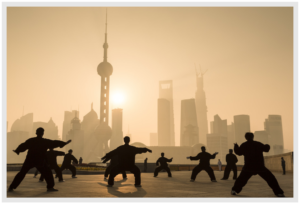Tai Chi Sessions
One thing moves, everything moves.
The origin of Tai Chi is still a subject of debate with scholars. Some say Tai Chi is hundreds of years old; others say thousands. One thing seems certain: The roots of Tai Chi are in ancient China. Tai Chi means “the ultimate.” The contemporary author Waysun Liao describes Tai Chi as “improving and progressing toward the unlimited.” Twentieth century Chinese Renaissance man Professor Cheng Man-Ch’ing, who developed a form with 37 postures based on the Yang (pronounced yong) Family Style, called Tai Chi the “supreme ultimate.” Edward Bilanchone has studied this form, the Yang Short Form, for more than 20 years.
The Tai Chi form is an internal martial art, meaning it does not rely solely on hard kicks, punches, and strikes for it to be effective. It has self-defense applications, but is used by many today as a way to become healthy and stay that way. It is said that one who practices Tai Chi continuously develops the “strength of a lumberjack, the pliability of a child, and the wisdom of a sage.”
The Tai Chi form is done slowly with a set of five movement principles. The movement principles are:
- Spine upright
- Relax and sink
- Move from the center
- Differentiate full and empty
- Wrists relaxed and straight
Most people start with the solo form. Some go on to learn either a form with a partner, called tuoi sho (pronounced twee sho, translated as “push hands”), or a form with a sword.
Ed began learning the solo form in 1988 as part of his Alexander Technique training. It was difficult and exciting to learn a new way of moving, and it was a great time to practice the principles of the Alexander Technique. From 1986, when he began to study, he knew Alexander’s principles would be useful for his golf game, but he didn’t make the same connection with Tai Chi at first.
“Tai Chi was a wonderful practice,” Ed remembers, “but I couldn’t see how it could help my golf game and teaching. The breakthrough came when I finally emptied enough chronic tension from my upper body (neck, shoulders, and arms) so that my weight could sink. Relax and sink is considered by many to be the most important Tai Chi principle. As I began to experience gravity pass through my body into the ground, allowing me to move from my center, make a fuller turn in my backswing, and finish with better balance, my golf swing improved dramatically.”
Suddenly, he began to see parallels between Tai Chi and golf everywhere: The basic movement in golf is weight shift and turn. In Tai Chi, adherence to the movement principles creates a weight shift and turn that produces maximum power for golf by getting the mass of the body behind and inside the ball before impact. Tai Chi can also train golfers to avoid the dreaded reverse pivot and over-the-top move. Balance is a premium in golf; without it there can be no accuracy and distance. Tai Chi goes a step further to say that without balance, there is no relaxation. Your body cannot be truly relaxed if it is out of balance. Balance and relaxation are the key to a fluid application of force. The mental game in golf requires clear intention, decreased mental chatter, and the ability to overcome distractions. Tai Chi speaks of quieting the monkey mind. The Chinese have a saying that the mind is like a monkey in a fruit tree, jumping from this piece of fruit to that, unable to remain focused on one thing for any length of time. There are many more parallels between golf and Tai Chi—too many to list here.
Tai Chi is the best off-course study for professional and amateur golfers seeking to consolidate the various parts of the golf swing into an integrated whole. Practicing Tai Chi gives you the tools to excel when it’s time to perform the golf shot under pressure. Golfers are most welcome to come to Smart Moves for Living to study Tai Chi, as are Tai Chi practitioners who wish to learn golf.
~ Ed Bilanchone

